HR 6060: The Closest Ever Solar Twin?
Gustavo F. Porto de Mello
Universidade Federal do Rio de Janeiro, Brazil
gustavo@ov.ufrj.br
Licio da Silva
CNPq/Observatorio Nacional/Brazil
Abstract
We show that the photometric and spectroscopic data of the G2V type
star HR 6060 (18 Sco) makes it the best ever solar twin (Porto de Mello
& da Silva 1997). This result is a by-product of a detailed abundance
survey of 25 chemical elements in 15 nearby G-type stars, with very
high S/N, high resolution spectra. Atmospheric parameters were
determined from the excitation & ionization equilibria of 106 Fe I
lines and 12 Fe II lines, theoretical fitting of H\alpha profiles
and the calibrations of Teff against (B-V), (b-y),
(R-I) J and beta colors. The best previously claimed solar
twin is 16 Cyg A, with the same Teff and [Fe/H] as the Sun but
being older, brighter, with lower gravity and a quieter chromosphere
(Friel et al. 1993). HR 6060 shares with the Sun the same Teff,
log g, [Fe/H], microturbulence, projected rotation velocity,
chromospheric activity and Li and Be abundances. Its galactic orbit is
also very similar to the Sun's. Yet its luminosity (HIPPARCOS), and thus
its age, is very slightly higher than the Sun's: its abundance pattern,
also, is curiously non-solar. Additionally, we have inferred a new, very
precise solar (B-V) from the database of our spectroscopic survey.
1. Detailed Spectral Analysis
We performed a detailed, rigorously differential spectral analysis with
respect to the Sun. Stellar spectra with resolving power R = 29,000
have been acquired at the 4m CTIO telescope. The continuum sinal-to-noise
ratio ranges from S/N = 300 (lambda 4500) to S/N = 1600
(lambda 6400). Solar gf values were generated from Ganymede spectra,
observed with the same instrumental setup as the stellar spectra, and
a modified MARCS atmospheric model (Edvardsson et al. 1993). For the Sun,
we adopted: Teff = 5.777 K, log g = 4.44 and xi = 1.20 Km/s.
The results for HR 6060 are: Teff = (5817 ± 30) K (Fe
excitation), Teff = (5768 ± 40) K (H alpha), T
eff = (5771 ± 60) K (colors), log g = (4.45 ± 0.12) dex
(Fe ionization), [Fe/H] = (+0.05 ± 0.05) dex and xi = (1.22
± 0.05) Km/s. The weighted mean value is Teff = (5789
K ± 24) K. Internal errors in the atmospheric parameters are:
sigma (Teff) = 30 K, sigma(log g) = 0.12 dex,
sigma([Fe/H]) = 0.05 dex and sigma(xi) = 0.05 Km/s. The
internal mean uncertainty in the [X/Fe] ratios is sigma = 0.06 dex.
In figure 1 we plot the individual Fe I line abundances against lower
excitation potential. The high quality and robustness of the results,
as well as the absence of systematic effects, are appreciated. In
figure 2 we compare for the Sun (Moon) and HR 6060 the observed
H alpha profiles, obtained at the Observat\'orio do Pico dos Dias
(CNPq/LNA/Brazil), with R = 20,000 and S/N = 200: they are seen to be
indistinguishable even at the line core.
In figure 3 we show the abundance pattern of HR 6060, with respect to
the Fe abundance, for 24 chemical elements. The abundance distribution
in HR 6060 is solar but for the slight overabundance of Sc and V and of
the heavier elements. In figure 4 we compare a short range
of the solar and stellar blue spectra: the similarity between the Sun
and HR 6060 is striking even in this spectral range, which is particularly
sensitive to metal abundance differences. In figure 5 we compare the Fe
I line strengths of the Sun and HR 6060. The line strengths in the two
objects are the same within the 1% uncertainty. The next best solar
twins, the 16 Cyg A and B pair, have Fe lines 3% stronger than in the
Sun (figures 6a,b) according to the data of Friel et al. (1993). The
data of Hardorp (1982) at 20 Å resolution, in the
3640-4100 wavelength range, imply HR 6060 and 16 Cyg A to be
weaker-lined than the Sun, 16 Cyg B having exactly solar-like features.
Our and Friel et al.'s much higher-resolution data do not correspond
to Hardorp's data, suggesting errors in his near UV line difference
magnitude indices of up to 0.05m.
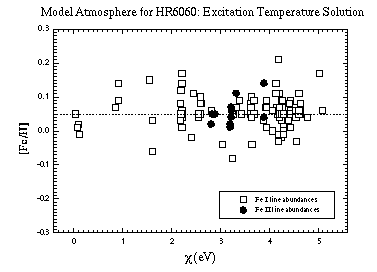 FIGURE 1.
FIGURE 1.
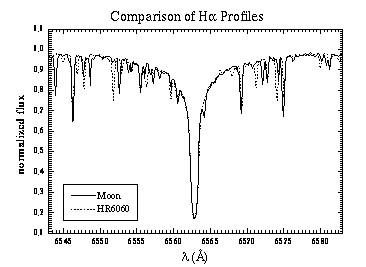 FIGURE 2.
FIGURE 2.
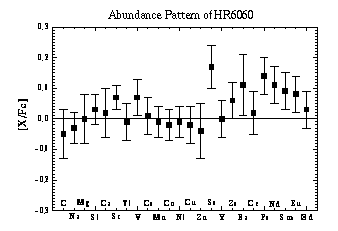 FIGURE 3.
FIGURE 3.
 FIGURE 4.
FIGURE 4.
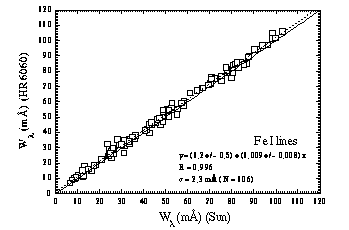 FIGURE 5.
FIGURE 5.
2. Chromospheric Activity, Rotation, Light Elements
Available Mount Wilson HK indices (Duncan et al 1991.) imply the
same degree of chromospheric activity in the Sun (Savg = 0.177) and
HR 6060 (Savg = 0.174). The H alpha line core residual fluxes are
exactly the same in the two stars (figure 2), also implying the same
degree of activity. Our estimated projected rotation velocity for HR 6060
is vseni \leq 3,0 Km/s, from a selected set of Fe I lines with very
clean profiles. The abundances in HR 6060 of log N(Li) < 1.4 (Soderblom
1983) and log N(Be) = 1.15 ± 0.15 (Boesgaard & King 1993) are
solar: log N(Li)sun = 1.16 ± 0.10 and log N(Be)sun =
1.30 ± 0.10 (Grevesse & Noels 1993) (all these values in the log
N(H) = 12.00 scale). The Li depletion data suggests that HR 6060 has about
the same age of the Sun. 16 Cyg A also shows the same Li depletion as the
Sun, as contrasted to the slightly cooler and more Li depleted star 16 Cyg B
(Friel et al. 1993). Both 16 Cyg stars are however appreciably less active
with Savg ~ 0.150 (Duncan et al 1991). Friel et al. (1993) also
found appreciably deeper cores in the Ca II infrared triplet lines for the
16 Cyg pair, with respect to the Sun.
3. Evolutionary State, Age
The HIPPARCOS parallax gives 14.0 pc as the distance to HR 6060. Assuming
the same bolometric correction for the Sun and HR 6060, log (L/Lsun) =
+0.020 ± 0.008 results. In figure 7 the Sun, HR 6060 and the 16 Cyg
stars are compared in a HR diagram. One infers the same mass for the Sun
and HR 6060. Taking into account that the Sun does not lie over the 4.5
Gyr isochrone, the inferred age of HR 6060 is \sim 6.0 Gyr. Morell et
al.'s (1992) analysis of the [Th/Nd] cosmochronometer pair arrived at the
same [Th/Nd] abundance ratio --- and hence the same age --- for the Sun
and HR 6060. The 16 Cyg stars are therefore appreciably older and more
evolved than both the Sun and HR 6060: this is confirmed by their lower
gravity (Friel et al. 1993).
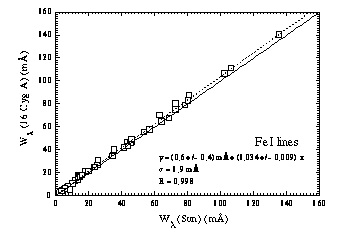 FIGURE 6a.
FIGURE 6a.
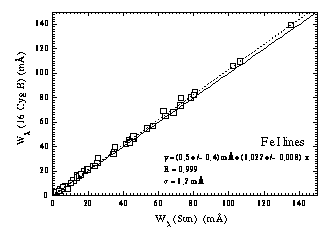 FIGURE 6b.
FIGURE 6b.
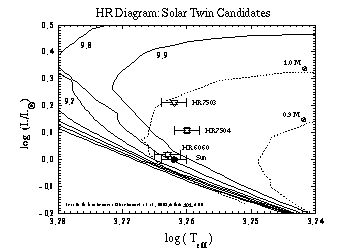 FIGURE 7.
FIGURE 7.
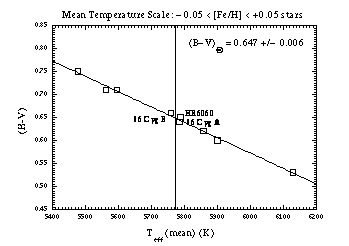 FIGURE 8.
FIGURE 8.
4. Galactic Kinematics
Woolley et al.'s (1970) galactic orbital parameters for HR 6060, by
adopting for the Sun a mean galactocentric distance of Rm sun
= 8.0 Kpc, imply Rm(HR 6060) = 7.8 Kpc. These same authors provide
as orbital eccentricities e(HR 6060) = 0.12 and esun = 0.07. Cayrel
de Strobel (1996), in her large review of the solar analogue subject,
gives as kinematical parameters: (U',V',W')sun = (+9,+12,+7),
(U',V',W')HR 6060 = (+38,-4,-18). HR 6060 is therefore a typical
middle aged, thin disk star, never venturing much either outside the solar
circle or the galactic plane --- just like the Sun.
5. The Solar Colors
We derived the solar (B-V) from our detailed spectral data, by plotting
the observed colors of the [Fe/H] = +0.0 stars of our sample
(augmented by 16 Cyg A and B) against their mean (H alpha, Fe excitation
& ionization, photometric) effective temperatures. We have deduced
(B-V)sun = +0.647 ± 1 0.006 (figure 8), in excellent agreement
with the results of Neckel (1986), (B-V)sun = +0.650, Gray (1995),
(B-V)sun = +0.648, and Cayrel de Strobel (1996), (B-V)sun =
+0.642. In the diagrams one sees that HR 6060 and 16 Cyg A are about
equally similar to the Sun in their (B-V) color.
6. Conclusion
We conclude that, for low resolution work, either HR 6060 or 16 Cyg A can
successfully act as a solar proxy in the night sky. For higher resolution
observations, or if one is interested in very fine differences in stellar
atmospheric parameters, however, HR 6060 is the most solar-like star
discovered to date.
We acknowledge financial and institutional support from
CNPq/ON, UFRJ/ Department of Astronomy and Fundaçao José
Bonifácio.
References
Boesgaard & King 1993, AJ, 106, 2309
Cayrel de Strobel 1996, A&AR, 7, 243
Duncan et al 1991., ApJS, 76, 383
Edvardsson et al. 1993, A&A, 275, 101
Friel et al. 1993, A&A, 274, 825
Gray 1995, PASP, 107, 120
Grevesse & Noels 1993, Origin and Evolution of the Elements
Hardorp 1982, A&A, 105, 120
Morell et al. 1992, A&A, 259, 543
Neckel 1986, A&A, 159, 175
Porto de Mello & da Silva 1997, ApJ Letters, 482, L89
Soderblom 1983, ApJS, 53, 1
Woolley et al. 1970, Roy. Obs. Ann., 5
[Contents]









